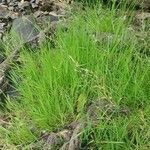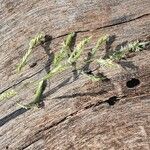A grass which keeps growing from year to year. It grows near the edges of water and has floating stems. It forms clumps due to underground stems or rhizomes. The stems stick up like a stiff grass with supporting roots from the lower stem joints. The leafy stems can be 60 cm high. The stems are hollow. The leaves can be 0.5-20 cm long and 0.3-1 cm wide. They are dull green and sword shaped and taper towards the tip. The leaf sheath is thickened and with dense white bristles at the base. It has rough upward pointing prickles on the higher section. The flower panicles are 5-15 cm long. They are open and with few branches. The small spikes have one flower containing both sexes. The lower flower bract has 5 veins.
Aquatic or semiaquatic perennial, rhizomatous. Culms erect, clambering or floating on water surface, 0.3–1.5 (–2) m long. Leaves: basal sheath terete, glabrous; ligule 1–6 mm long, chartaceous; blade 5–24 cm long, 2–10 (–16) mm wide, glabrous or scaberulous to hispid. Panicles 5–10 (–15) cm long, contracted to open, ±narrow, with branches erect or appressed. Spikelets 3.2–5 (–6) mm long. Floret: lemma oblong-elliptic, 3.2–6 mm long, acute to acuminate or caudate, awnless, with 5 hispid or ciliate nerves, the stiff hairs to 0.5 mm long on keel but shorter on marginal nerves and fairly inconspicuous on lateral nerves; stamens 6, anthers (1.5–) 2–3 mm long.
Perennial; culms 30 cm. to 1 m. high, slender, often decumbent, ascending from a creeping rhizome, silky pubescent at the nodes.. Leaf-blades mostly 10–20 cm. long and 4–8 mm. broad, flat, painfully retrorsely scabrid on the midrib beneath; ligule 1–2 mm. long, asymmetric, truncate or obliquely truncate.. Panicle narrowly elliptic to oblong, 5–12 cm. long and 1–4 cm. wide; branches ascending, bearing spikelets almost to the base.. Spikelets oblong, (3.2–)3.4–4.8(–5.2) mm. long and (1–)1.2–1.4(–1.7) mm. broad, pale or purplish; lemma conspicuously pectinate-ciliate, or rarely spinulose, on the keel.. Fig. 9/11.
Usually decumbent and rooting from the lower nodes, 3–15 dm; sheaths retrorse-scabrous, prolonged into 2 erect narrow lobes (1–)2–6 mm; ligules as long as the sheath-lobes and adnate to them; main lvs 3–15 mm wide; panicle 5–15 cm, its branches erect or ascending, some of them floriferous to the base; spikelets erect or appressed, little imbricate, 3–5 mm, a fourth to a third as wide; lemma ciliate on the keel and margins, glabrous or minutely hispidulous on the sides; stamens 6; seed seldom set; 2n=48. Swamps, marshes, and wet fields; pantropical, extending n. to Tenn. and s. Va. (Homalocenchrus h.)
Perennial, 0.3-1.0 m high; hygrophyte; rhizome creeping; culm nodes hairy. Leaf blade 100-200 x 4-8 mm, flat, strongly scabrous; ligule an unfringed membrane. Inflorescence a panicle, narrowly elliptic to oblong, branches ascending. Spikelets 3.4-4.8 x 1.2-1.4 mm, unconventional and hard to interpret, oblong, strongly laterally compressed; glumes absent or reduced to a very obscure rim at apex of pedicel. Floret 1, bisexual; lemma conspicuously pectinate-ciliate; lemma and palea keels with stiff hairs 0.2-0.6 mm long; anther 2.0-3.2 mm long. Flowering time all year.
Aquatic perennial; culms slender, erect from a decumbent or creeping base, rooting at the lower nodes, 0.5 to more than 1 m. long, the nodes retrorsely hirsute; sheaths shorter than the internodes, keeled, glabrous, auriculate, the auricles acuminate; ligule 1-3 mm. long, truncate, fused with the auricles; blades 4-20 cm. long, 4-12 mm. wide, scabrous; panicles 4-15 cm. long, narrow, the short branches 1-4 cm. long, narrowly ascending, floriferous nearly to base; spikelets 3 mm. long, hispid, strongly hispid-ciliate on the keels of the lemma and palea; stamens 2.
Perennial 300-1000 mm high; hygrophyte; rhizome creeping; culm nodes hairy. Leaf blade 100-200 x 4-8 mm, flat, strongly scabrous. Inflorescence narrowly elliptic to oblong, branches ascending. Spikelet 3.4-4.8 x 1.2-1.4 mm, oblong; lemma conspicuously pectinate-ciliate; lemma and palea keels with stiff hairs 0.2-0.6 mm long; anther 2.0-3.2 mm long.
Leaf-laminae 7·5-18(-30) x (0·2)0·3-0·8(-1·6) cm., narrowly linear, tapering to a fine point, expanded or involute, glaucous to bright green, somewhat rigid, rarely flaccid, straight or curved, usually glabrous, scaberulous but usually very scabrous at the margins towards the base.
Lemma as long as the spikelet, obliquely semi-elliptic to oblong, cartilaginous to chartaceous, keel and margins with a row of usually stout cilia which are straight or slightly curved, flanks slightly hispid or rarely glabrous, apex usually produced into a short blunt tip.
Culms 40-85(-125) cm. tall, many-noded, simple or branched, erect or ascending from a geniculate base, often rooting at the lower nodes, sometimes floating, usually slender and weak but sometimes stout, striate, glabrous but densely and shortly hairy at the nodes.
Perennial, hydrophyte and rhizomatous (rhizome creeping), up to 1 m high. Leaf blades 100-200 mm long, 4-8 mm wide (flat, strongly scabrous). Culm nodes hairy. Spikelets 3.4-4.8 mm long, 1.2-1.4 mm wide; lemma and palea keels with stiff cilia 0.2-0.6 mm long.
Panicle 5-10(-15) cm. long, narrow, contracted to open, erect or somewhat nodding, often partly enclosed by the uppermost leaf-sheath; rhachis furrowed, scabrous; branches suberect or rarely spreading, filiform, flexuous, angular, scaberulous or smooth.
Perennial; up to 1 m high; hydrophyte; rhizome creeping. Culm nodes hairy. Leaf blades 100-200 x 4-8 mm; flat; strongly scabrous. Flowers: panicle open; spikelets 3.4-4.8 x 1.2-1.4 mm; lemma and palea keels with stiff cilia 0.2-0.6 mm long.
Palea slightly shorter than the lemma but of the same consistency, with the keel ciliate, flanks hispid or rarely glabrous, apex usually subacute or rarely tapering to an acute point.
Leaf-sheaths finely striate, terete, the lowest often loose, the upper tight, usually shorter than the internodes, scaberulous or smooth, glabrous, auricled at the mouth.
Spikelets (3·2)3·4-4·8 (5·9) x 1·2-1·4(-1·7) mm., obliquely oblong to oblong-elliptic in lateral view, yellowish-green, often tinged with purple.
Slender, long-rhizomatous perennial to 1 m, hairy at nodes. Leaves linear-lanceolate, scabrid. Spikelets in an open panicle, purple.
Ligule (0·9)1·5-2·5(-3·4) mm. long, usually asymmetric, obliquely truncate, sometimes lacerate.
The retrorsely spinulose midrib of the leaf can inflict most painful lacerations.
Culms ascending from a rhizomatous base, forming matted carpets 30–90 cm. high
Racemes 1-5 on each branch, with the 3-10 spikelets usually densely imbricate.
A perennial with long stout branched rhizomes, more rarely caespitose.
Anthers 2-2·8(-3·2) mm. long, linear-oblong.
Pedicels very short.





